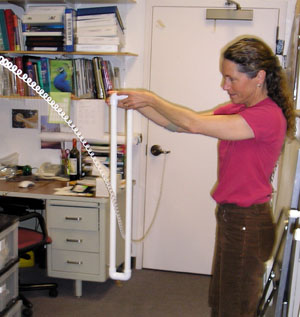
A wave on a cord models polarized light. A PVC rectangle models the action of a polarizing filter.
Introductory activity

History
The French scientist Arago noted that light reflecting off glass at an angle had special properties. Further experiments convinced him that these properties came about because light is a transverse wave. He named these properties polarization.
Today is is simple to do an experiment like that done by Arago. Look at light reflecting from a glass window at a 45 degree angle (approximately). Look at the reflection again through polarized sunglasses. Standing normally you will be able to see the reflection, rotate your head 90 degrees so your eyes are on a vertical line and the reflection almost disappears. (Photographers use polarizing filters to control reflections.) It was harder for Arago to do this experiment since he didn't have polarized sunglasses.
Before Arago scientists realized that when light passes through tourmaline crystals it is polarized (in the language of Arago) and that when light goes through calcite crystals in certain directions it is polarized.
A great breakthrough in the study of polarized light came about because Dr. Herapath was doing studies by feeding dogs quinine. His assistant accidentally dripped iodine into the dog urine. When the dog urine evaporated small crystals remained. Examining these crystals under the microscope Dr. Herapath noted that where the crystals crossed at right angles light was blocked. The mineral is known as herapathite and it polarizes light.
Edwin Land, who founded the Polaroid corporation, embedded herapathite crystals in plastic sheet then stretched the plastic sheet to align the crystals and make a sheet polarizer. Later he discovered that certain plastics exposed to iodine would act as polarizers. The polarizing films you see today are almost always made by this process of iodizing plastic.
According to an early 20'th century model of light, light is an electromagnetic wave. The electromagnetic wave is made of an electric field wave oscillating perpendicular to a magnetic field wave. The direction of oscillation of the electric field wave is the direction of polarization of the light.
When light hits an electron the electron
accelerates.
When light is linearly polarized in the vertical direction the
electron accelerates in the vertical direction, i.e. up and down.
Horizontally polarized light accelerates the electron right and
left.
Polarized light can also accelerate the electron in a clockwise circle, this is right circularly polarized light. There is also left circularly polarized light that accelerates the electron in a counterclockwise circle.
Each photon has a polarization. A collection of photons with different polarizations makes unpolarized light.
When unpolarized light made of photons with all directions and types of polarization strikes a linear polarizing sheet only one direction of linearly polarized light passes through the sheet.
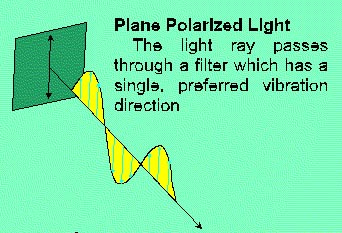
After passing through a linear polarizer the direction of
oscillation of the electric field of light is linear.
When light reflects off a nonmetal such as water, plastic, or paint at an angle known as Brewster's angle it is linearly polarized parallel to the surface. At other angles near Brewster's angle it is partially polarized. If light reflects perpendicular to the surface, the reflection will not polarize the light.
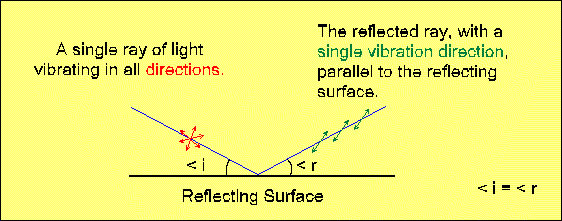
After reflection at Brewster's angle randomly polarized light
becomes linearly polarized parallel to the surface.
You can see polarized light effects using a pair of polarized sunglasses.
Polarized sunglasses snack
The index of refraction and so the speed of light in some materials depends on the direction of polarization of the light.(calcite or stressed plastic for example.) You can see this by placing these materials between two sheets of polarizer or by using a laptop computer screen which is a source of polarized light. A materiel with an index of refraction that depends on the polarization of the incident light is called birefringent. A clear birefringent material may become colored when viewed between two polarizers.
The Exploratorium exhibits Relative Motion Pendulum and Two Wheels and a Ball allow excellent explorations of models of polarized light.
The Relative Motion Pendulum uses a pendulum that swings at right angles to a table which is also a pendulum to allow you to add two sinusoidal oscillations at right angles to produce linear and circular polarized light depending on the relative phase between the two oscillations.
Two Wheels and a Ball shows that two circular motions can be combined to make a linear motion.
Together these two exhibits show that you can think of circularly polarized light as the sum of two linear polarizations that are 90 degrees out of phase. You can also think of linear polarized light as the sum of two circular polarizations in opposite directions. The angle of the direction of the linear polarized light can be changed by changing the relative phase of the two circular motions.
Edmund scientific sells a wire grid linear light polarizer.
http://www.edmundoptics.com/onlinecatalog/displayproduct.cfm?productID=2294&search=1
These polarizers consist of a thin layer of aluminum MicroWire sandwiched between two glass windows. Light polarized parallel to the wires is reflected, light polarized perpendicular to the wires is transmitted. The last statement is correct. It disagrees with the simple picket fence model of polarizers. In which waves polarized parallel to the slits in the picket fence are transmitted, while perpendicular polarizations are reflected or absorbed.
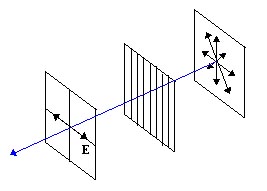
When randomly polarized light from the right passes through an
array of microwires it becomes polarized perpendicular to the
microwires.
This is the opposite to what is predicted by the picket fence model of polarized light, this classic model is shown here in an illustration by Paul Hewitt.
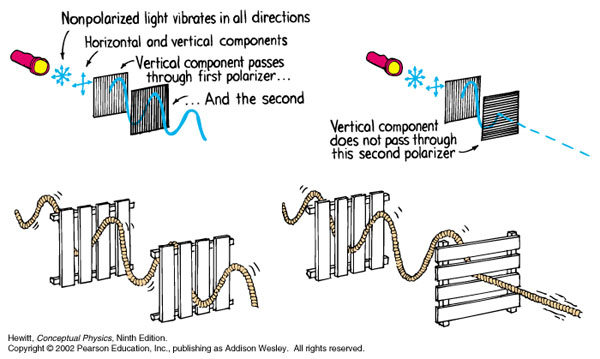
The picket fence model of polarizing light does not work for the most common plastic polarizer invented by Edwin Land and used in polarized sunglasses. In these plastic sheet polarizers the random chain polymers are stretched in one direction becoming long chains parallel to the direction of stretch. These polymers are coated with iodine. Electrons from the iodine can move with electrical resistance along the stretched polymers, they cannot move perpendicular to the polymers. When an electric field wave from light polarized parallel to the stretched polymers strikes the polarizer it pushes electrons along the direction of the stretched polymers. Electrons move in this direction removing energy from the light turning the lights into heat. When light polarized perpendicular to the stretch of the polymer strikes the polarizer electrons do not move and so the light passes through the polarizer without absorption.

Other exhibits which explore polarized light.
Bone Stress, snack use polarized light to show stress in Plastic.
Polarized light mosaic snack
Rotating Light, snack
Return to the Summer Institute
A website about polarized light.
http://www.polarization.com/index-net/index.html
|
Scientific Explorations with Paul Doherty |
|
18 March 20005 |